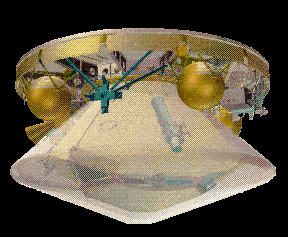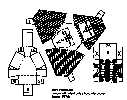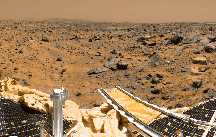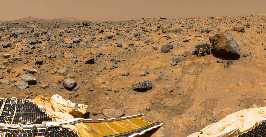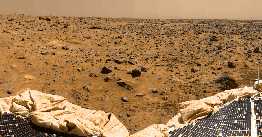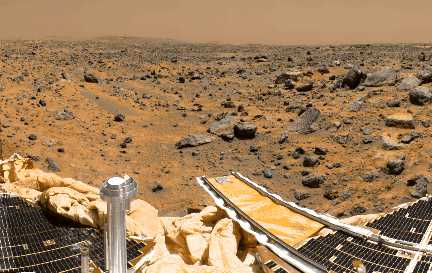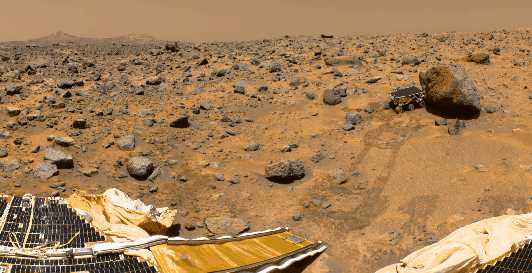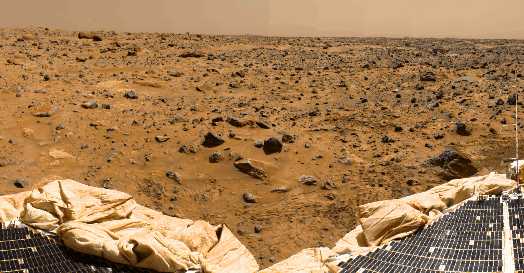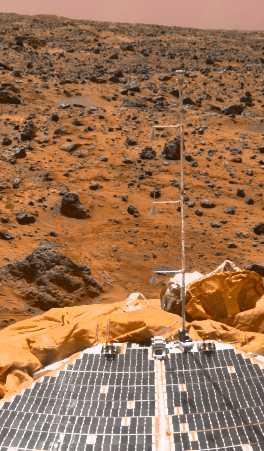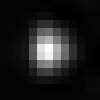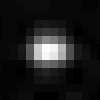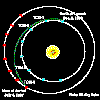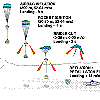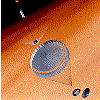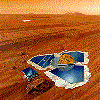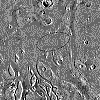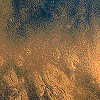| The "Big Crater" is actually a relatively
small Martian crater to the southeast of the Mars Pathfinder landing site.
It is 1500 meters (4900 feet) in diameter, or about the same size as Meteor
Crater in Arizona. Superimposed on the rim of Big Crater (the central part
of the rim as seen here) is a smaller crater nicknamed "Rimshot Crater."
The distance to this smaller crater, and the nearest portion of the rim
of Big Crater, is 2200 meters (7200 feet). To the right of Big Crater,
south from the spacecraft, almost lost in the atmospheric dust "haze,"
is the large streamlined mountain nicknamed "Far Knob." This mountain is
over 450 meters (1480 feet) tall, and is over 30 kilometers (19 miles)
from the spacecraft. Another, smaller and closer knob, nicknamed "Southeast
Knob" can be seen as a triangular peak to the left of the flanks of the
Big Crater rim. This knob is 21 kilometers (13 miles) southeast from the
spacecraft.
The larger features visible in this scene - Big Crater, Far Knob, and
Southeast Knob - were discovered on the first panoramas taken by the IMP
camera on the 4th of July, 1997, and subsequently identified in Viking
Orbiter images taken over 20 years ago. The scene includes rocky ridges
and swales or "hummocks" of flood debris that range from a few tens of
meters away from the lander to the distance of South Twin Peak. The largest
rock in the nearfield, just left of center in the foreground, nicknamed
"Otter", is about 1.5 meters (4.9 feet) long and 10 meters (33 feet) from
the spacecraft.
 This
view of Big Crater was produced by combining 6 individual "Superpan" scenes
from the left and right eyes of the IMP camera. Each frame consists of
8 individual frames (left eye) and 7 frames (right eye) taken with different
color filters that were enlarged by 500% and then co-added using Adobe
Photoshop to produce, in effect, a super-resolution panchromatic frame
that is sharper than an individual frame would be. This
view of Big Crater was produced by combining 6 individual "Superpan" scenes
from the left and right eyes of the IMP camera. Each frame consists of
8 individual frames (left eye) and 7 frames (right eye) taken with different
color filters that were enlarged by 500% and then co-added using Adobe
Photoshop to produce, in effect, a super-resolution panchromatic frame
that is sharper than an individual frame would be.
There is available a larger version of the same image: Big
Crater (Large - 4,928 KB)
 The
anaglyph view of Big Crater was produced by combining the left and right
eye mosaics (above) by assigning the left eye view to the red color plane
and the right eye view to the green and blue color planes (cyan), to produce
a stereo anaglyph mosaic. This mosaic can be viewed in 3-D on your computer
monitor or in color print form by wearing red-blue 3-D glasses. The
anaglyph view of Big Crater was produced by combining the left and right
eye mosaics (above) by assigning the left eye view to the red color plane
and the right eye view to the green and blue color planes (cyan), to produce
a stereo anaglyph mosaic. This mosaic can be viewed in 3-D on your computer
monitor or in color print form by wearing red-blue 3-D glasses.
There is available a larger version of the same image: Big
Crater (3-D Large - 3,284 KB)
|
